




Integrated planning results in places of learning that reflect the character, values, and vision of your college or university. W. M. Jordan Company offers insight and experience to help your team bring your visions to life.
Your concerns go beyond budgets and schedules. Today’s tech-savvy students expect the best equipment and technology available. They are concerned about sustainable design and its impact on the environment. W. M. Jordan Company teams with the finest designers to help you create elevated learning environments that help attract and retain the best students.
From Virtual Construction and Building Information Modeling to the latest tools for efficient construction operations, we use technological advances in our industry to enhance our project services. As builders first, our staff can help you make informed decisions about sustainability, constructability, life-cycle costs, and value that effectively and efficiently move your plan from imagination to reality.
W. M. Jordan Company serves the diverse needs of public and private places of learning. The delicate balance between budget constraints and the scheduling requirements of the academic year require a team with experience working on college and university campuses. We recognize the importance of minimizing disruptions to ongoing activities and stress both safety and security at each of our projects.
▶ Construction Management
▶ Design Build
▶ Real Estate Development
▶ Public Private Partnerships
▶ Virtual Construction
▶ Sustainability and Green Construction
▶ Preconstruction Services
Campus buildings must be built to withstand the test of time.. W. M. Jordan’s experienced staff can help you sift through the myriad options and develop the best combination of systems and materials to meet your budget and longterm needs.
We provide constructability analysis with an emphasis on value added options, sustainability, and durability. We can even develop Facilities Management Building Information Models to help your operations and maintenance staff do their jobs effectively, now and in the decades to come.
▶ Academic Buildings
▶ Athletic Facilities
▶ Data Centers
▶ Dining Halls
▶ Performing Arts Venues
▶ Science and Research Labs
▶ Student Centers
▶ Student Housing

Old Dominion University is a Research University serving more than 24,000 students. The Chemistry Building is a 110,500 square foot, four- story building with 13 teaching laboratories, 24 research labs, a tutoring/active learning center, faculty offices, and departmental administrative and technical support space for the Departments of Chemistry, Biochemistry and Biology. The building enables faculty, staff and more than 5,000 STEM-H students to do world- class research – all in one location.
Previously, chemistry classes were spread out over 28 locations across campus. Now, first-year students can attend class, go to labs, consult with faculty members and receive tutoring all on the first floor, and all within view of each other. A similar setup on the second floor holds classes and labs for sophomores. Much of the first two floors are visible from the outside through a large swath of glass creating “STEM on display.” Juniors and seniors participate in research with graduate students and faculty on the upper floors.
The 122- seat Michael and Kimthanh Lê Planetarium/Digital Theater serves as a planetarium, chemistry lecture hall, and seminar venue. It’s 3-D model simulation and cutting-edge high-resolution, dual-laser projection system projects images on a 49-foot dome in 4-K. Professors can project three-dimensional proteins and molecules, notes and videos on the dome, all at the same time.
An expansion of ODU’s existing chiller plant accomodates multiple buildings on campus, including this one. The team used Aquatherm pipe to allow a four-month CUP expansion to be completed over a five-week winter break.





▶ 2021 ABC VA Excellence in Construction
▶ Honor Award of Excellence
Educational - Public & Private Schools
▶ Allegiance Award
▶ 2021 ENR MidAtlantic Region Best Project Award, Higher Education/Research



Holden Hall houses the Mining, Minerals and Materials Science Engineering Program at Virginia Tech. The planned expansions and renovation of Holden Hall added a 5-story laboratory and instructional wing featuring new active learning spaces and a mock-min space where students can develop, build, test, and engage in national competitions for Autonomous Mining and Robotics. Renovations to Holden Hall included new laboratories, three 50-seat classrooms, cutting edge Center for Autonomous Mining and Robotics and a two-story space that allows students and faculty to engage in autonomous mining and work with natural materials that are three-to-four feet deep. This building also includes a new outdoor roof terrace, faculty offices and elevators.
$67.5 million in 2025 dollars • Construction Management at Risk • SmithGroup • Moseley Architects






Virginia Tech’s Hitt Hall and Dining Facility provides an expansion to the Myers-Lawson School of Construction as well as adding dining and academic spaces for students. Spanning three floors, Hitt Hall will include a 600-seat full service dining facility featuring multiple distinct dining venues which will increase dining services for students, faculty, and staff at Virginia Tech. The dining expansion also includes numerous support spaces for management and administration of this facility.
Hitt Hall provides Myers-Lawson School of Construction with innovation and discovery spaces for students such as a unique two-story Innovation Lab. This multipurpose facility also will also feature additional flexible general assignment classrooms with cutting-edge technology for students at Virginia Tech.
$66.3 million in 2025 dollars • Construction Management at Risk • Cooper Carry
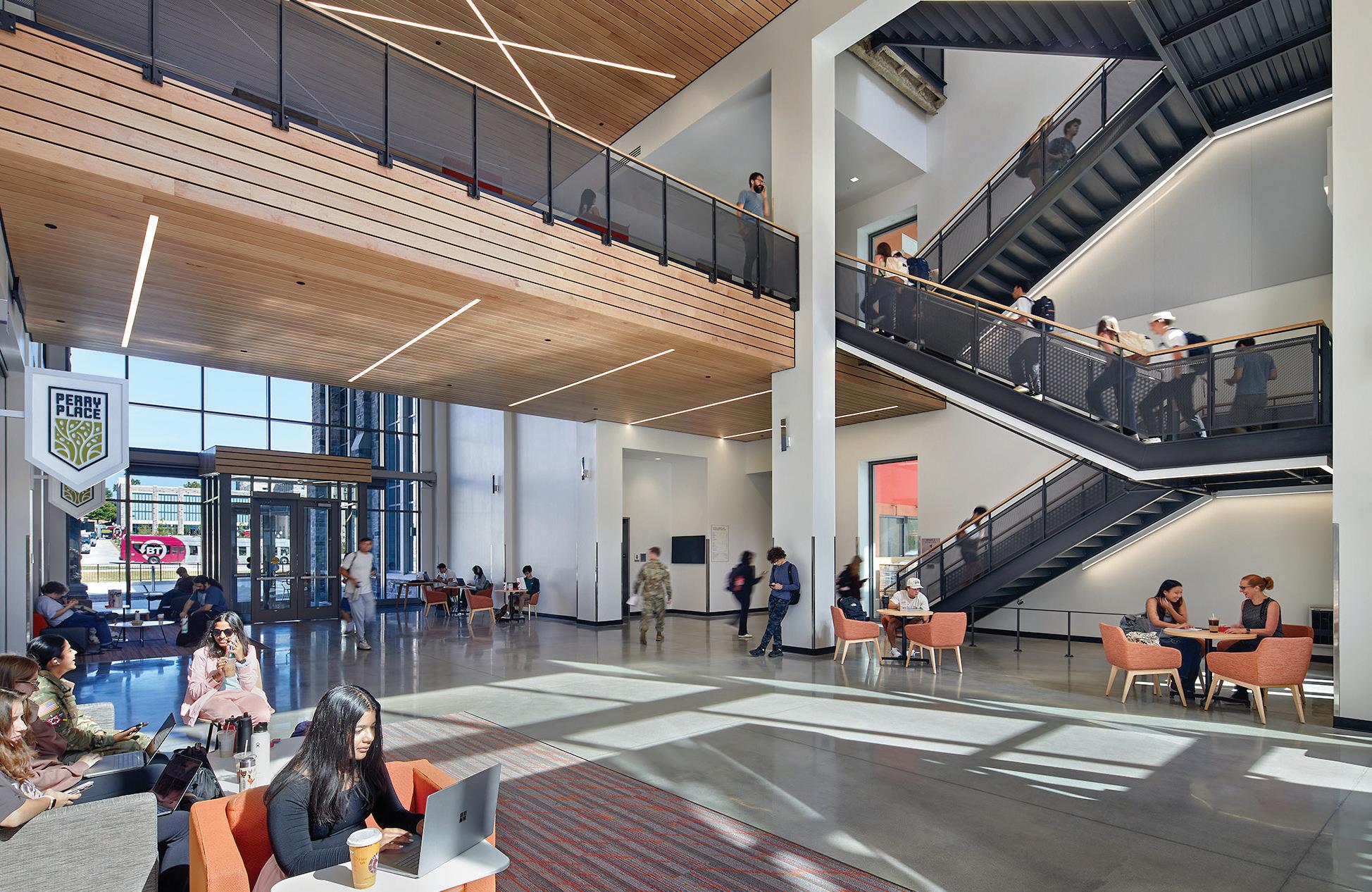


In a joint venture with Bordeaux Construction, W. M. Jordan Company provided general contracting services to renovate and expand the first floor of the existing, occupied Telecommunications Building at Duke University. The result is the Technology Engagement Center, a vibrant hub for technology innovation and experimentation. The expanded Co-Lab Studio is a makerspace with three multi-use workshops featuring workbenches, multiple 3D printers, and fabrication equipment such as laser cutters and computer-controlled cutting machines. A multi-discipline, multi-media conference room with an 8K video wall and the Ideation Room, an interactive learning suite, promote collaboration and idea sharing. The center offers a recording studio with a green screen and four recording and editing suites.
million








Virginia Tech’s Classroom Building brings the light of learning to students in a whole new way. The three-story building helps Virginia Tech prepare more than 10,000 students each semester live their motto of Ut Prosim: That I May Serve.
The building contains 15 state-of-the-art classrooms, four teaching labs and seating for 1,450 students. Teaching spaces support interdisciplinary team-based, technology-driven learning experiences. W. M. Jordan Company managed construction of this building, using Building Information Modeling for 3D coordination, 4D scheduling and pre-fabrication of building components.
$46 million in 2025 dollars • Construction Management at Risk • EYP Architecture


The Nash Community College Continuing Education/Public Services Training Facility is a two-story, 80,000 square foot facility featuring state-of-the-art equipment and instructional and classroom support. The building houses offices, a multipurpose room, 75-seat lecture hall, and support spaces. A firing range and Forensic Crime Scene laboratory support law enforcement training. Computer and simulation laboratories are housed in the new facility. The project team was composed of members from the Joint Venture of W.M. Jordan Company and Bordeaux Construction Company.






The University of Mary Washington Information and Technology Convergence Center is the new data center for the University of Mary Washington campus network. The Center houses the Speaking and Writing Centers, a Digital Knowledge Center, the computer HelpDesk, technology training activities, and the Division of Teaching and Learning Technology (DTLT). The 76,718 square foot, four-story, multipurpose facility is designed to facilitate the application of current innovative learning technologies and to provide smooth transitions to new technologies as they develop. A Digital Auditorium provides for entertainment, classes, lectures, training, and performances with flexible seating for up to 150 people. The building offers multi-function conference rooms, a digital gallery, classrooms, offices, a café, a “quiet study” zone and corridor niches that can be used for a variety of activities.
$37.4 million in 2025 dollars • Construction Management at Risk • Hanbury




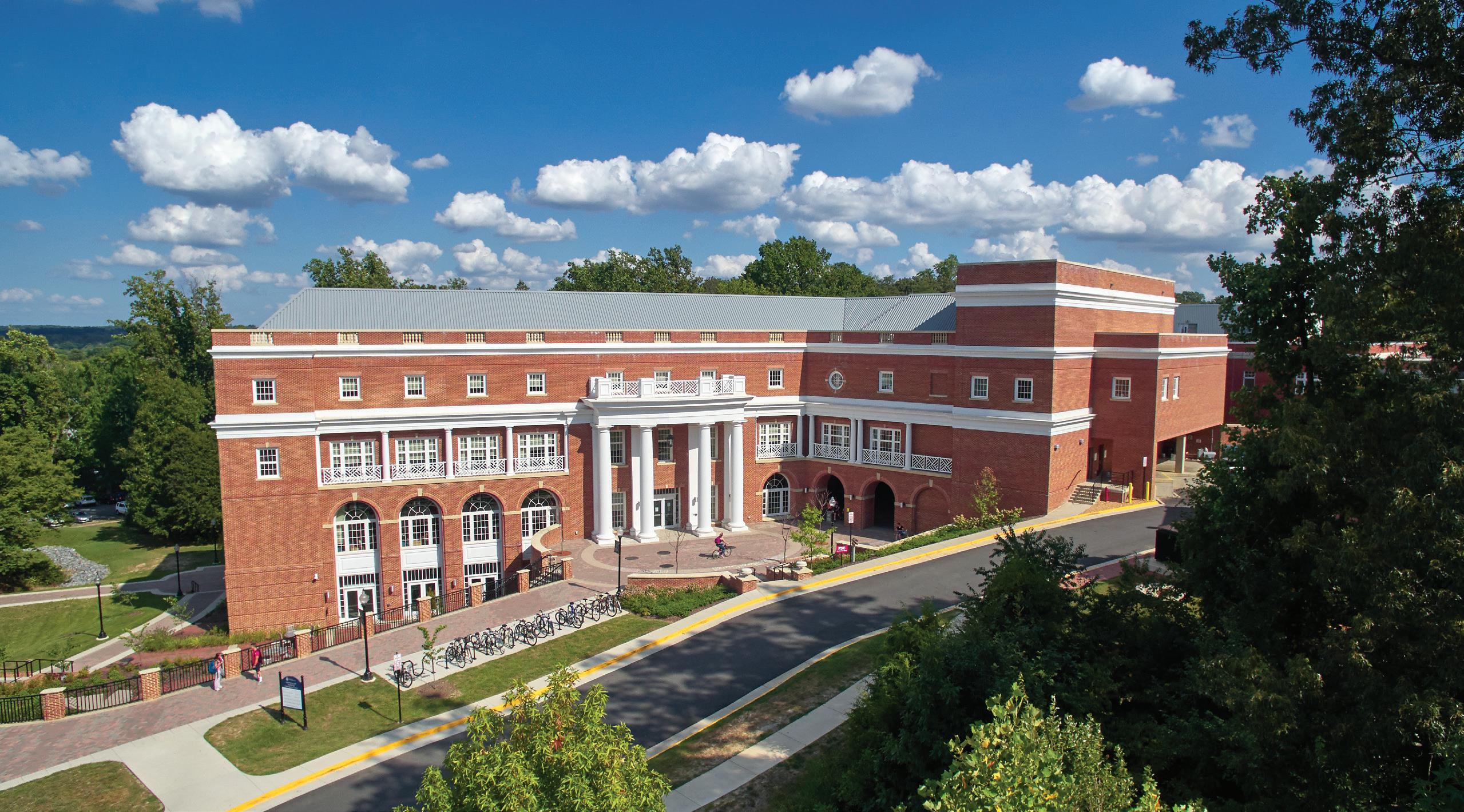

Virginia Tech uses this 91,000 square foot, state-of-the-art athletic training facility throughout the year for football and for spring sports such as baseball, softball, lacrosse and soccer. Sited on the east practice field adjacent to the football locker room, the facility accommodates the university’s football program by offering capacity for full-speed workouts and drills that could not be practiced in the previous indoor facility because of size constraints.
The building is 210 feet wide, 400 feet long and 85 feet high, allowing plenty of room for punting and kicking. Its eight-foot padded walls, wide sidelines, full scoreboard and 40-second clocks on each end allow the football team to hold a full-contact scrimmage. The floor is a durable artificial surface called Shaw Sports Turf Momentum, a high-performance synthetic turf system known for its durability and overall performance.
Stadium lights inside and outside of the building allow teams to practice well into the evening. If the team is practicing outside and it begins to rain, players can quickly move inside through the roll-up doors and continue practicing. The building has two observation decks; a lower one for observing practices, and an upper deck for filming practices.


▶ 2016 DBIA MidAtlantic Region
▶ National Award of Merit, Educational
▶ MidAtlantic Region Design Build Award, Educational
▶ 2016 ENR Mid-Atlantic Regional Award of Merit, Sports/Entertainment
▶ 2015 DBIA Hampton Roads Chapter, Educational





The Jimmye Laycock Football Center is a two-story, 30,445 square foot sports center. The project features eight coach’s offices, including a 500 square foot head coaching suite with a balcony view into Zable Stadium. Assistant coaches’ offices overlook the practice field. A 1,650 square foot grand entrance displays proud historical moments from the college sport’s program as well as Tribe Football Hall of Fame space.
The building’s first level is constructed with concrete masonry units and brick veneer, while the second level is steel framed with exterior wall studs and brick veneer. The center includes offices, meeting rooms, training areas, recruitment areas, locker rooms and classroom space as well as full and 1/2 full-length football fields. The rehabilitation of the football practice fields included regrading the existing fields, irrigation system and new turf.





Sherman Construction provided CM at risk services for this $10.9 million, 61,200 SF transformation to Clemson University’s Duckworth Family Tennis Facility increased their indoor court capacity by 30 percent. The 45,000 SF state-of-the-art indoor facility features six courts that replaced a smaller fourcourt facility and accommodates nearly 400 spectators with an elevated viewing level of bleachers, as well as three separate viewing balconies that overlook the exterior courts. Exteriorly, six tennis courts were added and the six existing courts were fully replaced. Additionally, the grandstands were entirely refurbished that also included new bleachers installation.
The new varsity court amenities boast individual electronic scoreboards and an overall match scoreboard. Also included in this project, a new 11,000 SF, two story clubhouse that replaced an outdated operations building. The clubhouse houses coaches and administrative offices, locker rooms, men’s and women’s lounge areas for players, sports medicine rehab area, hydrotherapy room, Hall of Fame, and spectator viewing areas of outside courts. Additional amenities include a rooftop plaza with capacity for up to 100 people, public rest-rooms on the ground level, and outdoor concession stands. Site improvements include an adjoining lot with 80 new spaces for guest parking.
Sherman Construction provided Design Build services to Clemson University for the new 88,218 SF Indoor Football Practice Facility. The core indoor football facility measures 410’x 210’and houses a full-sized regulation NCAA football practice field. A pre-engineered metal building with brick and metal panels was implemented that included translucent wall panels around the perimeter of the building, incorporated to maximize natural lighting.
Other support spaces within the facility include a training room, rest-rooms, storage, AV, mechanical and electrical rooms. The facility additionally features two filming towers at 55’-0”above the field and a center platform that allows both interior and exterior viewing.
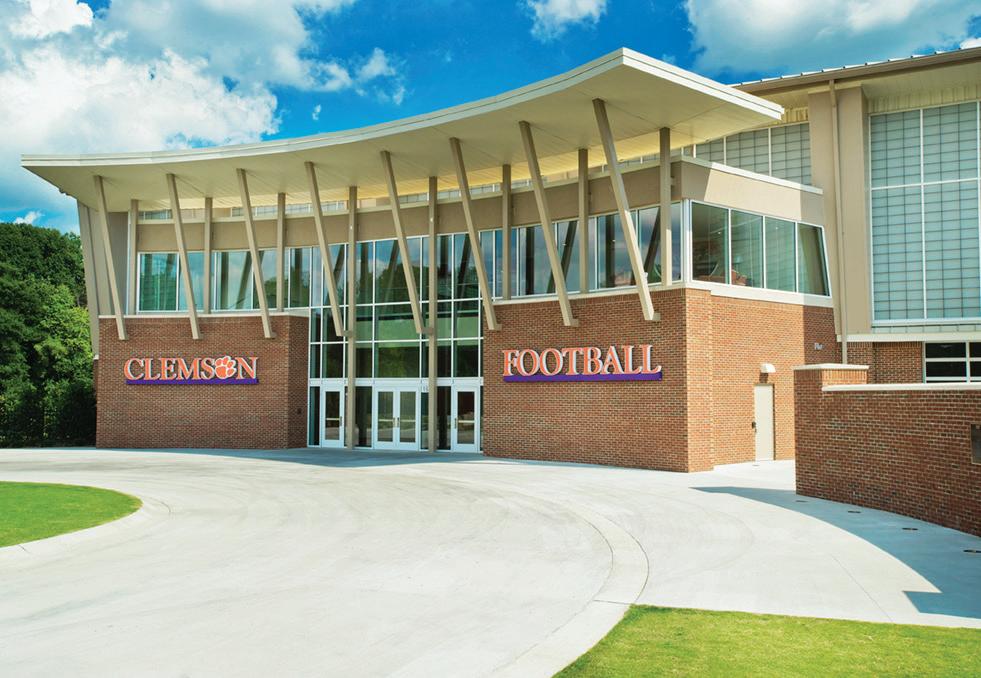
W. M. Jordan Company is building a 3,682 sf addition to this building. The $1.4 million addition adds storage for sports medicine equipment, along with hydration stations on the east end of the building.
$15.3 million • Design Build Services • Goodwin, Mills & Cawood Architects • Sherman Construction


Sherman Construction provided general contracting services to the University of South Carolina to construct this Indoor Football Practice Facility. The completed facility provides over 111,000 SF housing a full-sized regulation football field accommodating field goal kicking, as well as other support facilities, training and storage rooms. The building design and construction executed “green” building principles.

$17.6 million in 2025 dollars • Design Bid Build Watson Tate Savory & RATIO Architects • Sherman Construction

Sherman Construction built this 50,000 SF Student Center Annex, located on the bustling campus of Coastal Carolina University. The annex connects to and expands the existing Lib Jackson Student Center. This two-story facility provides oncampus entertainment options for the students at Coastal Carolina University allowing them to remain on campus if desired.
The Annex features a 200-seat movie theatre/ auditorium, game room, and lounge space. This project further includes conference rooms and retail services, as well as areas for student organizations to meet, and a courtyard area between the existing center and Annex which includes an area for entertainment venues.
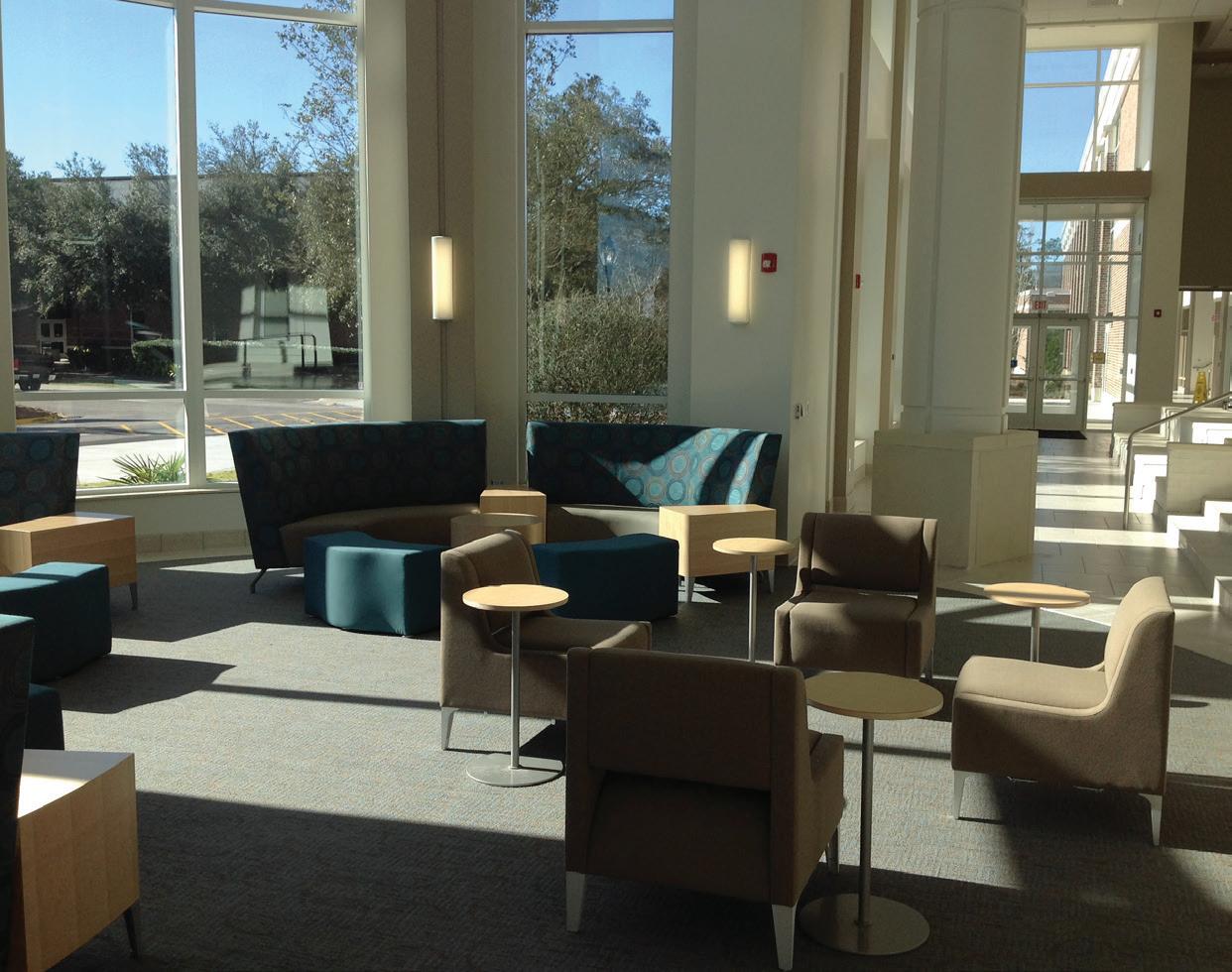

Liberty University, situated in the scenic city of Lynchburg, Virginia, initiated an impresseive new construction project on its North campus. The Liberty University Green Hall Parking Deck stands as a testament to modern engineering and thoughtful design. This expansive structure spans 71,169 square feet and rises seven stories high, offering 1,500 parking spaces to accommodate the growing needs of the university community.
In addition to the parking deck, the project includes a two-story, 11,200 square-foot addition dedicated to storage and office use, providing essential space for administrative and operational functions. The integration of Lean practices and meticulous planning ensured that the construction process minimized disruption to existing facilities, reflecting the university’s commitment to efficiency and sustainability.
$37.2 million in 2025 dollars • Construction Management at Risk • Bakervill



W.M. Jordan Company provided Construction Management at Risk Services for a new three-story, 38,285 square foot university campus dining hall for James Madison University. The new Phillips Dining Hall sits on the site of the old dining hall that was demolished by W. M. Jordan.
The new building features dining space and back-of-house cooking, prepping, storage and food serving areas, vertical circulation, stairs and elevators, common restrooms, a mechanical and electrical room and fire protection. This project was designed for and is seeking LEED certification.
$30 million in 2025 dollars • Construction Management at Risk • Perkins + Will Architects






Elizabeth City State University (ECSU) enhanced its campus with long-awaited renovations of two facilities, the two-story G. R. Little Library and Moore Hall, a two-story brick building constructed in 1922, listed on the National Register of Historic Places. The 90,510 square feet of renovations took place in two separate buildings, with one fully-operational building them.
Moore Hall includes 41,778 square feet of “dressed down to the studs” renovations, resulting in a finished high-quality facility that reflects ECSU’s project goal, to preserve this historic 100-year old educational facility while also providing new modernized classroom space. The building features 20 modern classrooms with state-of-the-art IT and projection equipment, new exterior windows, exterior masonry repair & replacement, cornice replacement, roof repairs, MEP upgrades, and renovaitons to the auditorium.
The concurrent renovation of G. R. Little Library resulted in a modern floor plan that meets the needs of the students, faculty, staff, and the public. The Library’s renovations included new flooring throughout, ceiling tile, MEP upgrades, elevator refurbishment, as well as removal and reinstallation of new hydronic PTAC systems.
$13.2 million in 2025 dollars • Construction Management at Risk • Woolpert Architects






A makerspace, a reading porch, 1,500 new seats and loads of natural light. VCU’s transformed James Branch Cabell Library is 277,477 square feet with 69,446 sf of new construction. The enhanced library provides flexible workspace with 90% of its square footage devoted to study space and student use rather than housing books. The original library, constructed in 1970 and expanded in 1975, served only 17,000 students. Designed for research, study and collaboration, the new library doubles the number of seats to 3,000. Over 63,000 weekly visitors enter its revolving doors.
Work included phased renovations of occupied space on four floors of the existing library. Renovations created a new Special Collections and Archives, staff and faculty offices, and an enlarged Starbucks Café. The addition contains the Circulation and Information Services Center; a collaborative, creative Makerspace lab; Innovative Media Studios, a multi-media laboratory with green screen capability and viewing/editing rooms; student work spaces with power and data connections; individual and group study areas; and a 300-seat presentation theater.
Located on Shafer Court, an important pedestrian gateway with an iconic compass paving pattern, the site reinforces the civic importance of the library as the heart of the campus. The library’s entrance façade engages students with new seat walls and views into Cabell’s study and learning spaces.
$56.6 million in 2025 dollars • Construction Management at Risk • Moseley Architects with Shepley Bulfinch



▶ 2016 ENR Mid-Atlantic Best Project Award, Higher Education/Research



The lobby of the 22,050 square foot Goode Theatre is animated with colored lights and projected images created by the students, beckoning visitors inside to see student performances. The department produced trailers of their plays which are projected onto the north wall of the lobby so that they were visible to all passersby.
The building includes a 3,300 square foot prop shop, a 2,400 square foot sound stage and a 2,200 square foot theater. The Theatre seats 167 guests on the first floor and an additional 56 guests at the balcony level. The second floor houses the dressing rooms and mechanical room.
The project team used a 3-D Building Information Model (BIM) to review spatial relationships and to maximize the layout of the Mechanical, Electrical, Plumbing and Fire Suppression Systems so as not to interfere with rigging and lighting.
$11.3 million






The Hampden-Sydney College Science Building exemplifies the college’s unwavering commitment to excellence in science education. This state-of-the-art facility is designed to foster collaboration and innovation, housing programs in Biology, Biochemistry, Chemistry, Environmental Science, Computer Science, Neuroscience, Physics, and Anatomy. Strategically located at the corner of College Road and Via Sacra, the new science building redefines this pivotal intersection at the heart of the campus. It enhances the adjacent central green space while respecting the established axis that connects important student residential areas to the north and south.
Spanning approximately 73,000 square feet, the facility is equipped with cutting-edge research and teaching labs, lab support and material management spaces, classrooms, student study areas, and faculty offices. This comprehensive design supports Hampden-Sydney College’s dedication to providing top-tier science education and promoting interdisciplinary collaboration. A notable aspect of the project is the restoration of the historic sightline between Cushing and Venable, a deliberate design element from the 1820s. Efforts were made to reclaim and reuse materials from Bagby Hall, including the cupola, which has been thoughtfully incorporated into the new building’s landscape. During the spring of 2020, three classes conducted meticulous architectural, photographic, and oral history documentation of the building, preserving its legacy.
$39.9 million in 2025 dollars • Construction Management at Risk • Hanbury






Virginia Tech’s Creativity and Innovation District (CID) Living-Learning Residence Center features over 30,000 sf of programmed space devoted to artistic, performance and research-based experiences that support meaningful connections between the CID, Virginia Tech, and the town of Blacksburg. Strategically located where the campus meets the town, its public gathering spaces invite visitors to mix, mingle and interact.
The six-story, 230,896 sf living-learning center has 596 beds including three graduate teaching assistant apartments and a resident faculty apartment. The center supports three living-learning communities. Student rooms are a mix of single, double and suite style, targeted towards Art, Architecture, Design and Construction majors. The suites, occupied by student athletes, are interspersed throughout the wings to integrate the athletes and arts populations, creating a diversity of encounters and opportunities to build community and collaborate. Residents who are not part of one of the three LLCs have a less specialized, broader experience with access to all programs and spaces.
Dressed in Virginia Tech’s signature Hokie Stone, the center is divided into three wings connected by a central spine. Learning and community spaces are sited along this central corridor on the first and second floors. Constant activity along the central spine, flooded with natural light and a high degree of transparency, encourages cross-disciplinary interactions. Gallery space and a performing arts theater are visible and accessible to residents of Blacksburg.
$103.1 million
Academic spaces include classrooms, an auditorium, library, visual and performing art studios, a black box theater and music practice rooms. The Maker Suite features a large assembly room plus metal, wood and welding shops. Transparent, acoustical glass systems and high, open spaces keep learning and creative enterprise on display. Multiple exterior courtyards, an outdoor classroom, glass pedestrian bridges and rooftop green spaces connect the living-learning community with the campus and the town.




▶ 2022 DBIA MidAtlantic Region
▶ Project of the Year
▶ Excellence in Architecture
▶ 2022 Student Housing Business Magazine Innovator Award - Best Implementation of Mixed Use or Live/Learn
▶ 2022 ABC VA Honor Award of Excellence, Commercial ($20 MM+)



Hampden-Sydney College, a private men’s liberal art college in Hampden-Sydney, Virginia, has been forming good men and citizens since 1776.
“The Grove” residence hall complex offers 150 young men a unique “cabin in the woods” experience designed to foster connections between one another and with nature. The complex consists of five residence halls, each bearing an arboreal name: Hickory, Oak, Osage, Poplar, and Sycamore.
Anchoring the southern end of the complex overlooking Chalgrove is the social hub of the Grove, the firepit and kayak outfitted Lodge. The timber framed structure features a brick fireplace, leather furniture, and sloped laminated wood ceilings creating a lodge-like environment and a welcoming, comfortable space to relax, study and socialize. Floor to ceiling windows provide panoramic views and blur the visual boundary between indoor and out. In warmer months, the deck provides a dining and meeting area with views of Chalgrove, where new docks and foot bridges enhance pedestrian access around the water’s edge.
T“he Grove apartments have quickly become the most in-demand residence halls on campus. Given our COVID-19 precautions, the open courtyard, fire pit, and the proximity to Lake Chalgrove and the Wilson Trail has provided students with a valuable setting to safely socialize and enjoy the fall weather.
Richard M. Pantele ‘13, Associate Dean of Students ”




Old Dominion University serves over 24,000 students. More than 5,000 of them live on campus, driving the university to create modern facilities geared to specific student populations with similar goals.
At 165,000 square feet, Hugo A. Owens House is the second-largest residence hall at ODU and the first to support the academic experience of residential students. Many of its students major in STEM-H: science, technology, engineering, math and health sciences. Living-learning communities focusing on cybersecurity, gaming, health professions and engineering allow students to take classes, study together and collaborate on projects, all without leaving the building.
The building honors the legacy of Dr. Hugo A. Owens, the first African American Rector of the University and a prominent civil rights activist and dentist in the community. Two resident wings contain 473 beds in a mix of single and double occupancy rooms. Academically focused resources dominate the first floor. A learning commons and collaboration space is provided at the south portion of the building, with offices and two classroom spaces at the north. Study rooms and a computer room with 22 terminals are open to students around the clock.
The Innovation Lab is a collaborative space with computers and 3-D printers where students can explore their creativity and test new ideas. Blending academic space with the learning commons and “great hall” living room encourages rigorous study and inquiry to feed the social fabric of the community.
$63.7 million in






The Paul Jennings Residence Hall is a 151,000 square foot, five-story residence hall combining living space and learning space as the next example of JMU’s Residential Learning Communities.
The 500-bed residence is designed primarily for first-year students. The first floor includes two classrooms, a multi-purpose room for events, a recreation room, a learning commons, and two faculty apartments. Each floor contains two study areas and three large lounges. The bathrooms are uniquely set up as pods containing three rooms, each with a toilet, shower and sink for a total of eight pods on each floor.
A large exterior courtyard featuers outdoor amenities such as bench seating, collaborative spaces, areas for food trucks, hardscapes and a paved walkway the leads to a land bridge constructed by W.M. Jordan to connect the path with neighboring residence halls and dining facilities.
$67.1 million





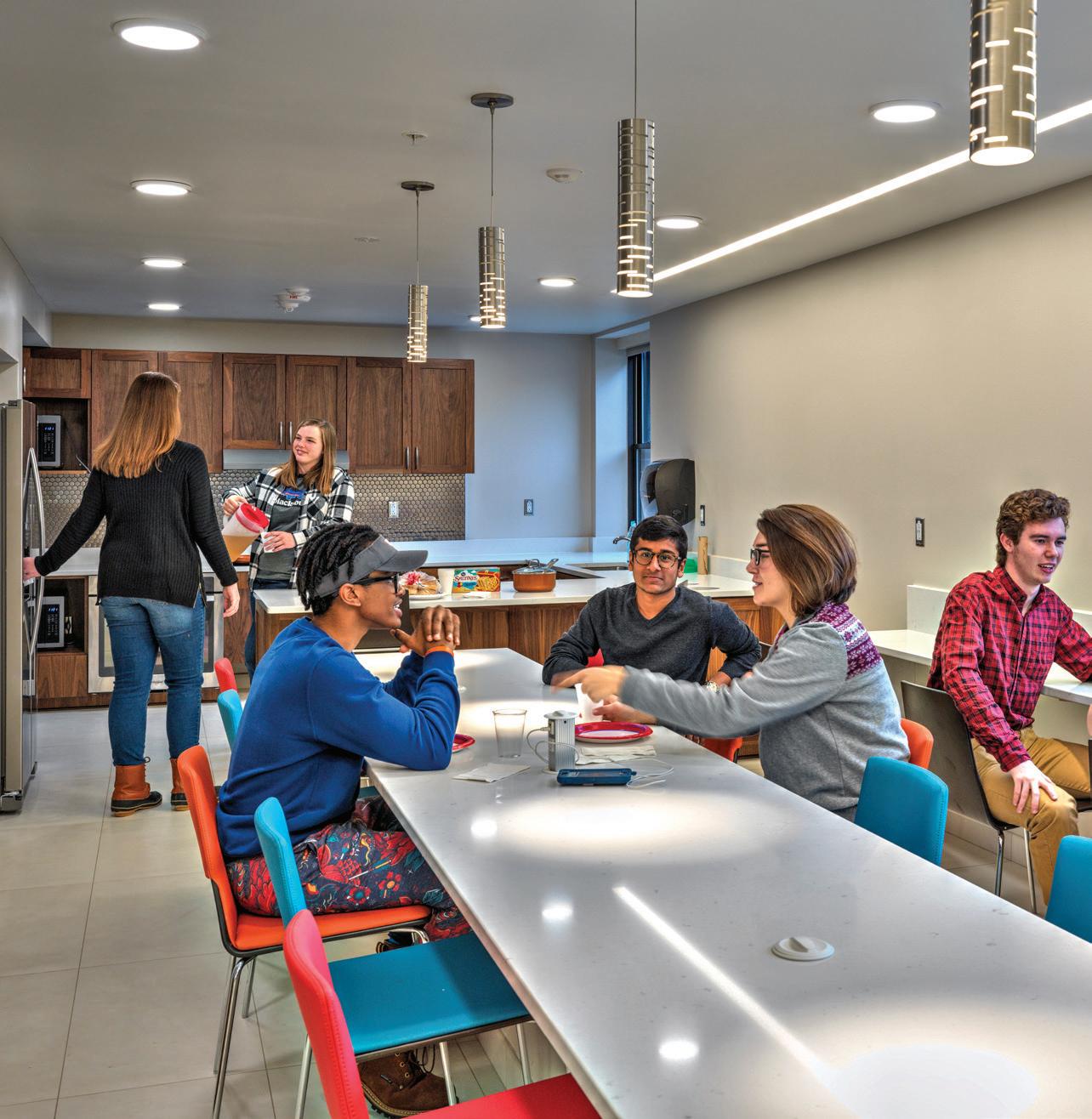


O’Shaughenessy Hall, originally built in 1969 in the President’s Quad, is 69,211 square feet, has seven floors plus a penthouse, and was converted from the standard “dormitory style” to a “residential college style”. The renovated residence hall includes 335 beds. The project added new HVAC units and all of the shared bathrooms were completely renovated.
The ground floor was transformed into a warm, inviting, inclusive, and collaborative environment. Public spaces include the Junior Commons Room, Community Kitchen, Library, Senior Commons Room, Faculty Offices, and a Classroom. A glass enclosed stair faces a landscaped courtyard with accessible sidewalks and ramps.
$23.7 million in 2025 dollars • Construction Management at Risk • Moseley Architects


Virginia Commonwealth University, an urban campus in Richmond, Virginia with an enrollment of more than 31,000 students, needed a lot of student beds, quickly. Traditional procurement methods were inadequate to the task, taking too long and diverting financial resources from the university’s core academic mission. VCU turned to the P3 process, selecting American Campus Communities (ACC) to provide a turn-key solution that delivered 1,522 beds in only 30 months.
Gladding Residence Center is a 12-story, high-rise, classic-style residence hall designed primarily for first-year students. The 371,000-square foot building replaces outdated on-campus housing with modern accommodations and adds 500 new beds to the campus housing stock. Home to nine specialized livinglearning communities, GRC provides a modern livelearn environment for residents and dedicated work space for University Residential Life and Housing.


▶ 2019 ABC VA Excellence in Construction
▶ Overall EIC Award
▶ Honor Award of Excellence, Public and Private Schools
▶ 2019 Student Housing Business Magazine
Innovator Award - Best New Development by a College, University or Institution
The Gladding Residence Center was designed to fit and built to suit, and VCU got everything they wanted in the building: unit types, a neighborhood configuration, common amenities designed for their specific target market, and office space for all university residence life staff.
$114.2 million in 2025 dollars • CM at Risk under American Campus Communities Clark Nexsen Architecture & Engineer, Architect of Record • Ayers Saint Gross Design Architect



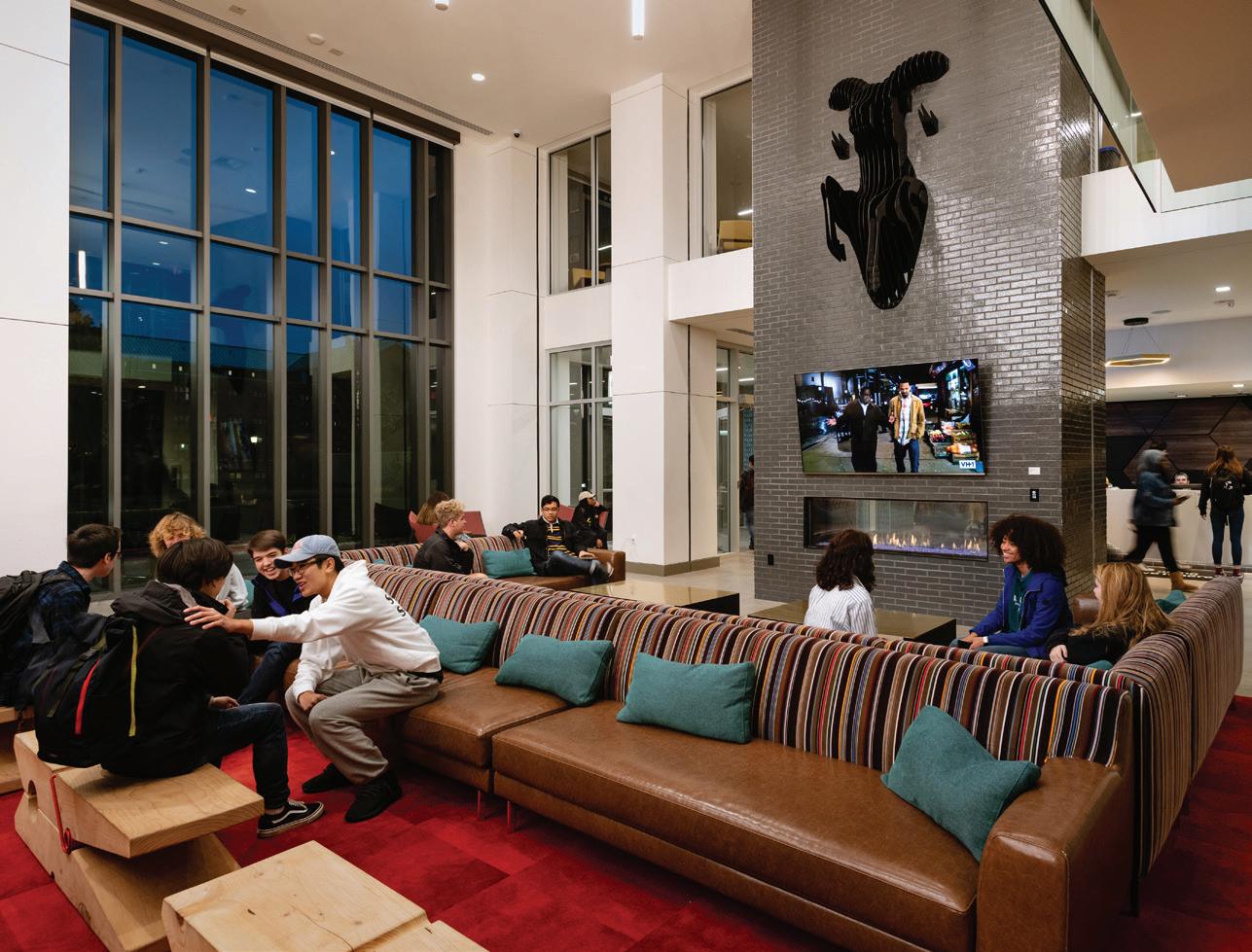


UVA’s Alderman Road Residences replaced an aging residential complex built in the 1960’s with modern facilities that foster intimate, secure and close-knit communities for growing numbers of first-year students.
The first floor of each building features multipurpose gathering spaces, laundry, study and lounge, and classroom spaces. Each upper floor contains student bedrooms, two communal bathrooms, a central loung and quiet study spaces.
This project was designed with sustainble features including native landscape with no landscape irrigation, low flow plumbing fixtures, high performance building envelopes, dual wheel energy recovery units, occupancy sensors and lighting controls, enhanced commissioning, and low VOC finishes.

▶ 2014 DBIA Mid-Atlantic Honor Award, Educational
▶ 2014 Engineering News Record Safety Award of Merit
$78 million in 2025 dollars • Clark Nexsen Architecture & Engineering






The College of William and Mary is the birthplace of the American college fraternity.The Phi Beta Kappa Society, founded on December 5, 1776, was the first collegiate fraternal organization in the United States of America. The College celebrates its long tradition of supporting campus fraternal organizations with a new Fraternity Housing complex.
Eleven new brick homes with three different floor plans are appropriately scaled to the size of each chapter. Each house has unique exterior façade features and warm and cozy interiors that allow residents to reflect the individual character of their group. A new community center offers space for students to gather and hold events. The complex has a total of 187 beds in 85,000 square feet of space.
The complex is designed to be environmentally sensitive and save energy costs. All of the houses are designed to LEED® certification standards.
$32.8 million in 2025 dollars • Construction Management at Risk • Moseley Architects





Virginia Commonwealth University embarked on an ambitious construction project to enhance student housing options, resulting in the creation of the Grace and Broad Residence Center. This innovative complex offers a Living-Learning Community for 396 students, fostering a vibrant and engaging environment. The Grace and Broad Residence Center consists of two distinct 5-story buildings, each with its own unique architectural character, facing different streets. These buildings are home to two specialized living-learning communities aimed at nurturing future leaders and entrepreneurs.
A key feature of this project is the collaboration between the Design-Build team and the university to repurpose the entire first floor of the Broad Street building. This space has been transformed into retail and Collaborative Incubator areas, providing students with opportunities to support and develop their entrepreneurial endeavors. The residential units within the complex are designed to offer comfort and convenience. Each four-person single bedroom apartment boasts urban loft-style windows, full kitchens with modern appliances, air conditioning, Wi-Fi, cable TV, and 24-hour security.
The Grace and Broad Residence Center has achieved LEED® Silver certification, reflecting its commitment to sustainable design and environmental responsibility. This project not only enhances the living experience for students but also contributes to the university’s broader goals of sustainability and innovation.
$50.5 million in 2025 dollars • Design Build • Clark Nexsen



Douglas Development - off campus graduate student housing serving VCU, VCU Medical Center, Virginia Union


W. M. Jordan Company provides construction and real estate development services in Virginia and the Carolinas. Founded on the values of integrity and respect and powered by a culture of continuous learning and improvement, we focus on developing leaders, advancing innovation, and building our communities. While we integrate the latest and most advanced technologies in the business, our people carry out our mission: The relentless pursuit of excellence.
2024 $725,020,544
2023 $523,778,554
2022 $500,579,181
W. M. Jordan Company is a leader in providing professional construction and real estate development services. The firm focuses its efforts regionally, yet consistently ranks in the Top 400 Contractors nationally according to Engineering News Record, a leading industry publication, and is ranked among the Giants 300 by Building Design + Construction magazine. The firm is a privately owned S-Corporation headed by Ronald J. Lauster, Jr, President. Our bonding company is Travelers Casualty and Surety Company of America. Travelers is an A+ (Superior) A.M. Best rated insurance company (Financial Size Category, XV ($2 billion or more.) W. M. Jordan Company is nationally ranked, regionally based, and locally committed to each and every customer.
In 1959, William M. Jordan and Robert T. Lawson founded W. M. Jordan Company, Inc. with a commitment to excellence: to strive for quality in every job, regardless of the size of the project, the budget or the time frame. Fueled by this commitment, under the leadership of John R. Lawson, II since 1986, the company grew into an organization providing a broad range of services to a diverse clientele across Virginia, North
Engineering News Record
▶ Top 400 Contractors: #180
▶ Top 100 Green Contractors: #90
▶ Top East Contractors: #37
▶ Top Texas & Southeast Contractors: #95
BD+C Giants 400: #96


Greenville, SC
Charleston, SC

Carolina and South Carolina. After 32 years at the helm, John Lawson passed the reigns to Ronald J. Lauster, Jr. to continue the legacy of excellence. The corporate headquarters is in Newport News, Virginia. Regional and satellite offices allow us to best serve our clients across the region.
▶ Skilled in multiple delivery methods: Construction Management at Risk, Design Build, Design/Bid/Build
▶ Real Estate Development and Public-Private Partnerships
▶ Virtual Design and Construction
▶ Pre-Construction Services
▶ Sustainability and Green Construction
▶ Lean Construction Techniques
▶ Skilled in new construction, complex renovations, and historical adaptive reuse
▶ Nationally Ranked. Regionally Based. Locally Committed. ENR Top 400 Contractor | four regional offices and three satellite offices in VA, NC and SC
▶ Financially sound organization with annual revenues exceeding $700 million
▶ Substantial bonding capacity through Traveler’s Casualty and Surety Company of America, an A+ (Superior) rated firm
▶ In-house expertise in Preconstruction Services, Virtual Design and Construction, Building Systems and Lean Construction
▶ Extensive relationships with trade partners and suppliers
▶ Safety is a core value. W. M. Jordan Company is the first construction company to achieve Level 2 of the Virginia Building Excellence in Safety, Health and Training (VA voluntary compliance program.) All staff are OSHA-10 certfied and all field personnel are OSHA-30 certified.
▶ History of strategic joint venture and mentor-protege alliances
▶ All projects are within a 2-hour radius of a regional office for customer and project team support.












Glenn A. Thompson, Vice President of Business Development gthompson@wmjordan.com 804.400.0708
Coastal Virginia
Erica Viola, Senior Business Development Manager eviola@wmjordan.com 757.298.3188
Central Virginia
Hayley Evans, Business Development Manager hevans@wmjordan.com 804.836.7770
Western Virginia
Ryan Stinnett, Senior Business Development Manager rstinnett@wmjordan.com 804.380.0388
North Carolina
John Cheshire, Senior Business Development Manager, Carolinas jcheshire@wmjordan.com 910.409.3680
Raleigh, North Carolina
Sholes Homewood, Business Development Manager shomewood@wmjordan.com 919.696.0103
South Carolina
Chris Dill, Business Development Manager cdill@wmjordan.com 864.419.3349